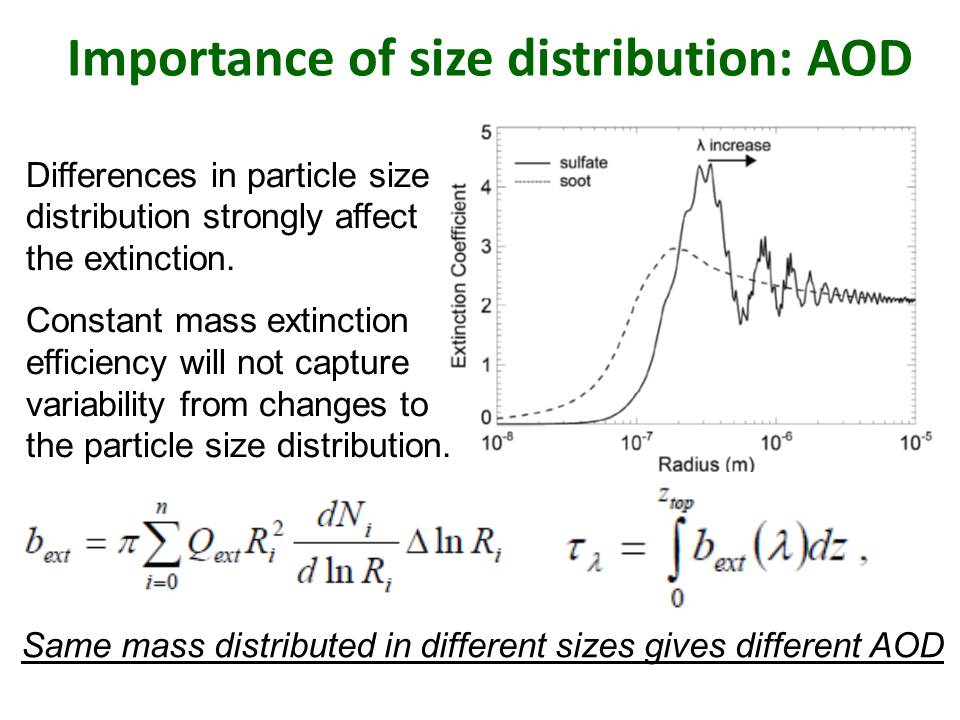UKCA Chemistry and Aerosol Tutorial 10
Back to UKCA Chemistry and Aerosol Tutorials
What you will learn in this Tutorial
In this tutorial you will learn about the Aerosol Optical Depth and how aerosol optical properties are diagnosed by RADAER GLOMAP-mode aerosol module and how it tracks different aerosol types within several size classes.
Task 10.1: What is the aerosol optical depth?
Aerosol particles affect the Earth's radiative balance by scattering and absorbing solar radiation and, where they are large enough, can also act as a greenhouse gas by absorbing outgoing terrestrial long-wave radiation.
The aerosol optical depth (AOD), sometimes referred to as aerosol optical thickness (AOT), is often used in atmospheric science to indicate the overall strength of aerosol-radiation interactions at a particular wavelength.
The AOD is defined as the vertical integral of the monochromatic (single-wavelength) extinction (the sum of scattering plus absorption) through the atmospheric column. It is common also to refer to an absorption AOD which represents the integral of just the single-wavelength absorption.
The Unified Model (UM) radiation scheme divides the shortwave and longwave spectra into wavebands. To enable UKCA simulated gases or aerosols to interact with the UM radiation scheme, their optical properties need to be integrated across each of these wavebands. For aerosols, the radiation scheme requires the specific scattering and absorption coefficients, which describe the strength of aerosol scattering and absorption processes per unit aerosol mass (in m kg), and the asymmetry parameter, which describes in a simplified way the angular dependence of the scattering (dimensionless). The specific scattering and absorption coefficients, and the asymmetry parameter, are hereafter referred to as the aerosol optical properties.
Task 10.2: Understand how the RADAER module diagoses aerosol optical properties from GLOMAP in UM-UKCA
Mie theory describes the scattering and absorption of light by spherical particles. Essentially, the scattering efficiency can be parameterized in terms of two parameters: the (complex) refractive index of the particle and the Mie parameter, which describes the particle size dependence in relation to the wavelength of light under consideration.
The Figure in the slide below shows the dependence on particle size of the scattering efficiency for mid-visible (550nm, green) light for two different types of particle (refractive index).
The aerosol scheme used for UK climate model simulations in CMIP5 is called the Coupled Large‐scale Aerosol Simulator for Studies In Climate (CLASSIC). CLASSIC is a simpler scheme than the microphysical GLOMAP scheme included in UKCA but has a comprehensive representation of the main aerosol sources, tracking up to eight tropospheric aerosol species: ammonium sulphate, mineral dust, sea salt, fossil fuel black carbon, fossil fuel organic carbon, biomass burning aerosols, secondary organic (also called biogenic), and ammonium nitrate aerosols.
However, the size distribution and refractive index for each of these aerosol types was prescribed to have globally and temporally uniform values.
For the CLASSIC aerosol scheme, aerosol optical properties are derived based on prescribed size distributions and refractive indices for each of several aerosol types.
These prescribed size distributions and refractive indices for each aerosol type
have no variation in time or space.
In Wavelength\-dependent specific scattering and absorption coefficients are obtained using Mie calculations from prescribed size distributions and refractive indices
Explain how this is this done for the CLASSIC aerosol scheme. Has the aerosol consisting of an external mixture of several aerosol types.
Explain how GLOMAP is different from CLASSIC. Represents the aerosol with size modes rather than aerosol types. Each mode consists of an internal mixture of different aerosol components.
The calculation of absorption and extinction aerosol optical depths from GLOMAP is carried out via RADAER within the routine ukca_radaer_compute_aod.F90
For more information read section 13.2 (pages 41-44) of the UKCA UMDP.
Task 10.3: Output daily-mean Aerosol Optical Depths from your UKCA model run
As well as the providing the waveband-averaged scattering, extinction and asymetry parameters from GLOMAP, RADAER also diagnoses monochromatic Aerosol Optical Depth (AOD) for each of the GLOMAP modes.
One thing that is not included in the UMDP is the STASH section and item numbers for these GLOMAP Aerosol Optical Depth diagnostics.
UM-UKCA diagnoses the AOD from each of the GLOMAP modes as a separate STASH item.
All of the GLOMAP AOD diagnostics are contained with STASH section 2.
Although this section contains mainly diagnostics associated with long-wave radiation, it is where the CLASSIC Aerosol Optical Depth diagnostics are stored, and there were plenty of spare item numbers there, which have accomodated also the GLOMAP AOD diagnostics.
Section 2 items 300-305 contain the AOD for the Aitken-soluble, accumulation-soluble, coarse-soluble, Aitken-insoluble, accumulation-insoluble and coarse-soluble modes respectively.
Note that there is no nucleation mode AOD as those particles are too small to significant scatter or absorb solar or terrestrial radiation.
Diagnostics for the absorption AOD in these 6 modes can be requested via STASH section 2 items 240 to 245.
There are also separate "stratospheric AOD" diagnostics in section 2 items 254 to 259 which can also be requested to store the AOD in levels above the tropopause.
The dimensions for each of these STASH items is 2D global in longitude and latitude but there is also a third dimension containing 6 pseudo levels for the 6 monochromatic AODs stored by the model.
The standard settings for these are to store AOD at 0.38, 0.44, 0.55, 0.67, 0.87, 1.02 micron wavelengths although any wavelength can be set by modifying the values set in the RADAER fortran code.
As an example I have attached here a .![]() pdf
pdf ![]() which compares the Aerosol Optical Depth (at 440nm) simulated in the UM-UKCA tutorial job comparing the jobs xjlub (top-left) and xjluc (top-right) which used the standard and 2-component OC configurations of GLOMAP.
which compares the Aerosol Optical Depth (at 440nm) simulated in the UM-UKCA tutorial job comparing the jobs xjlub (top-left) and xjluc (top-right) which used the standard and 2-component OC configurations of GLOMAP.
Written by Graham Mann 2014


